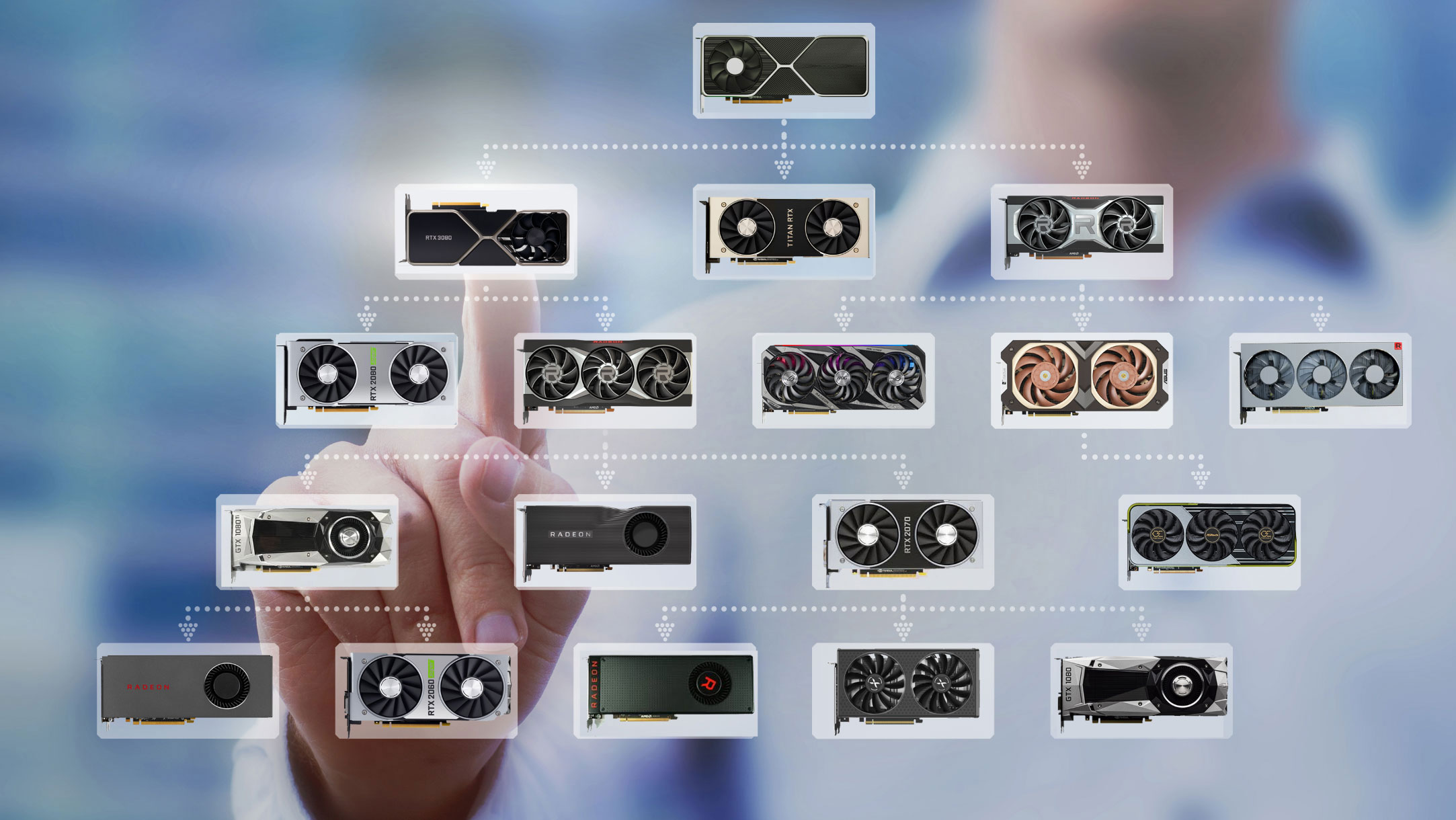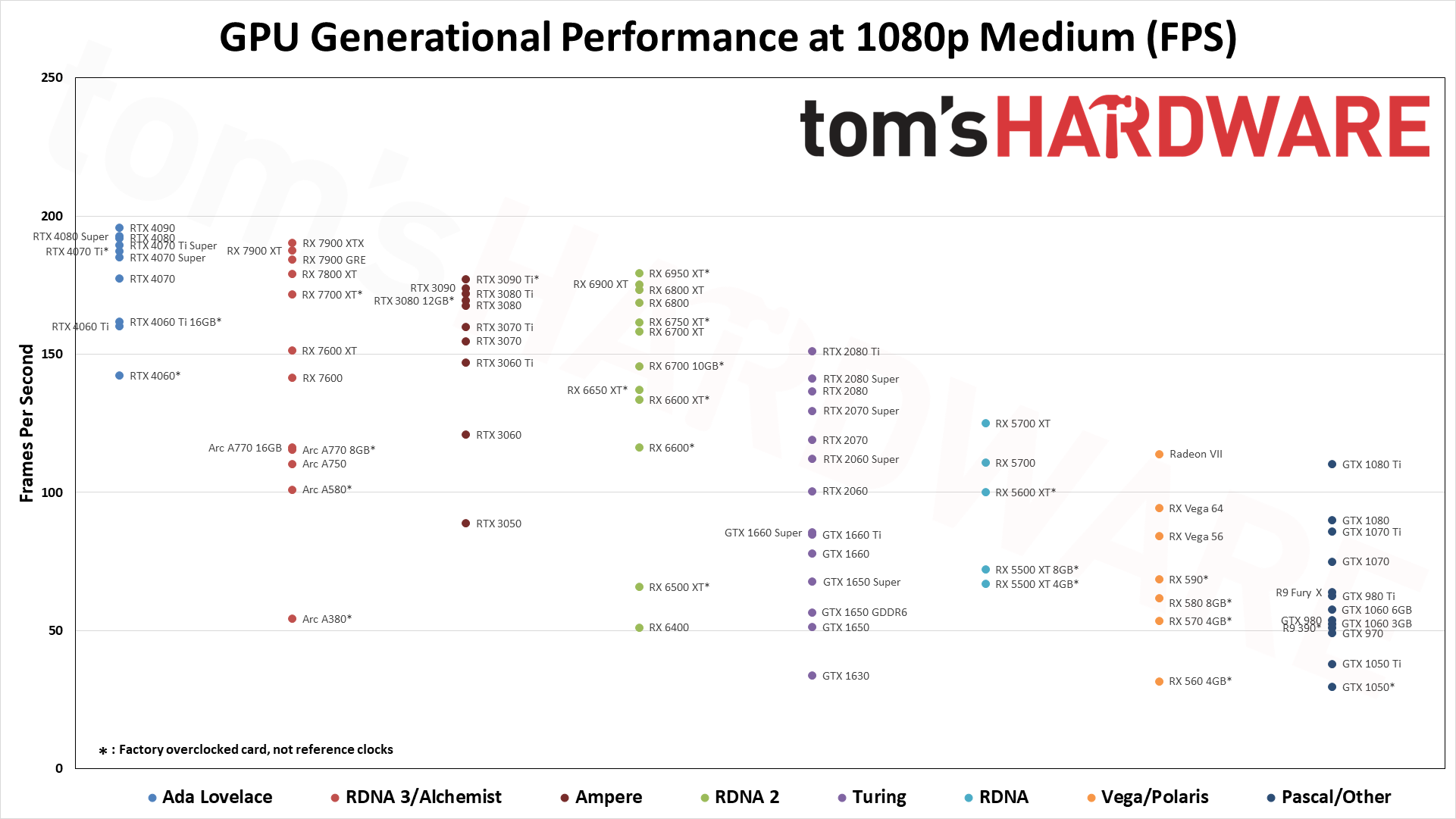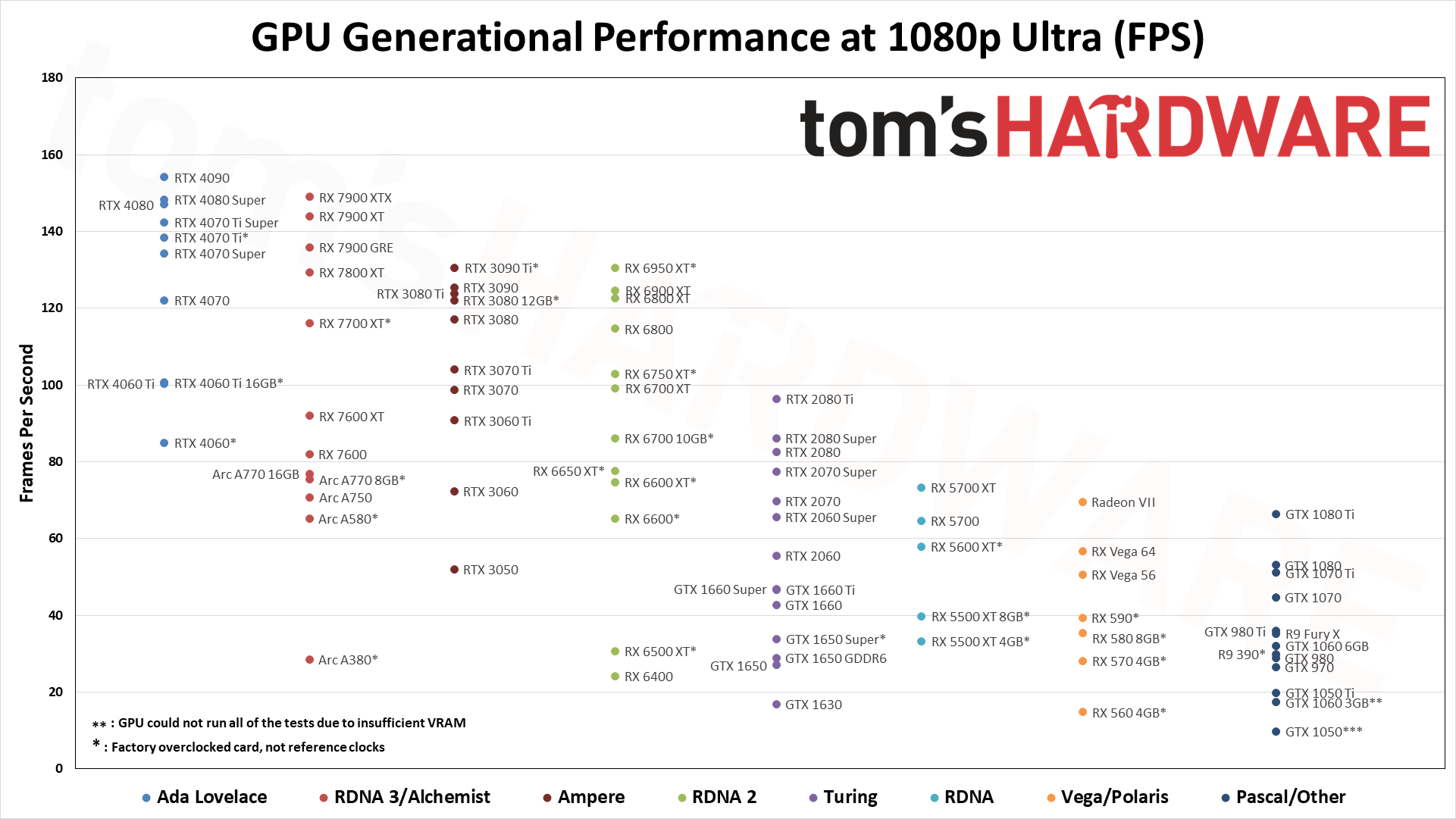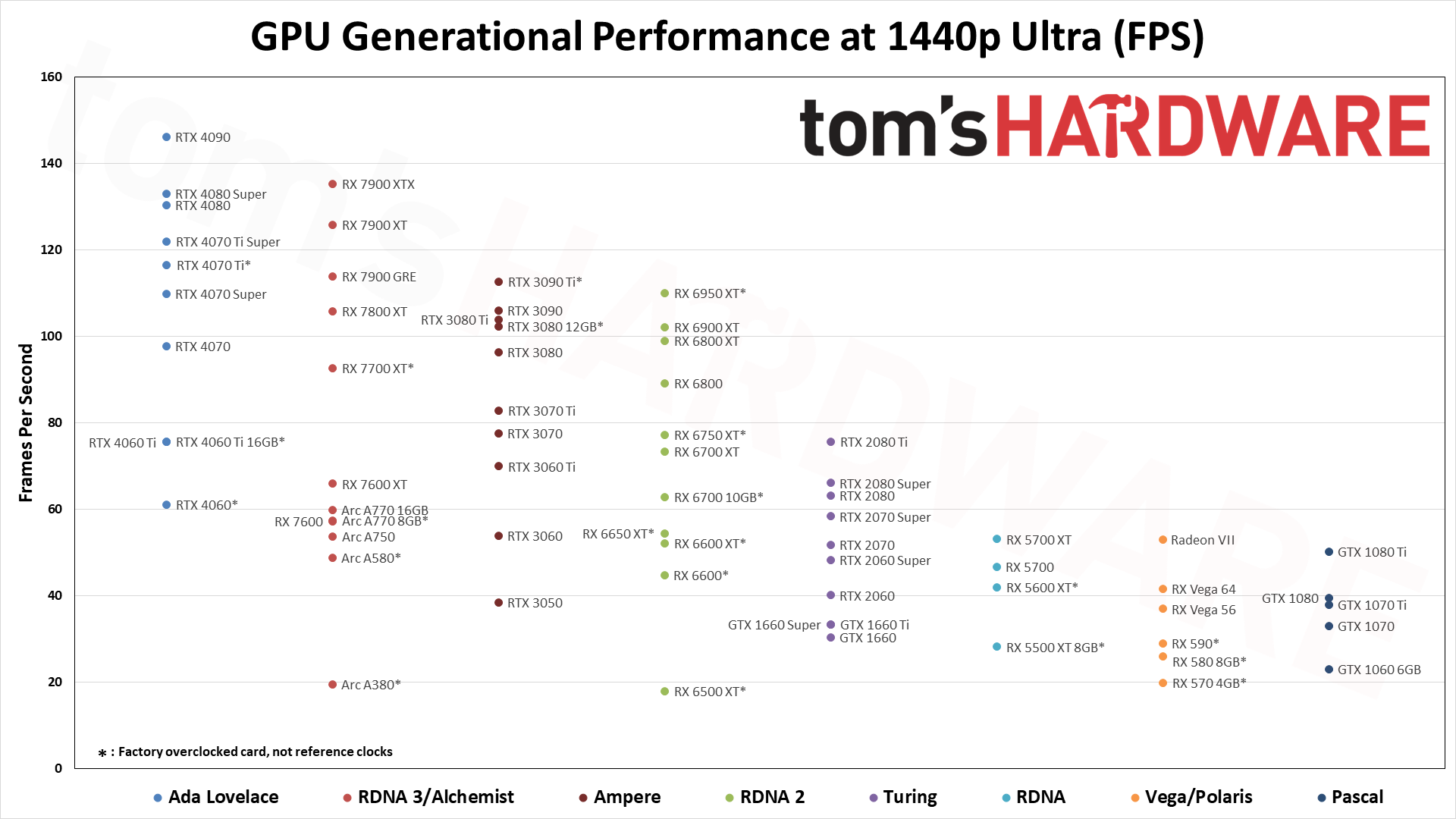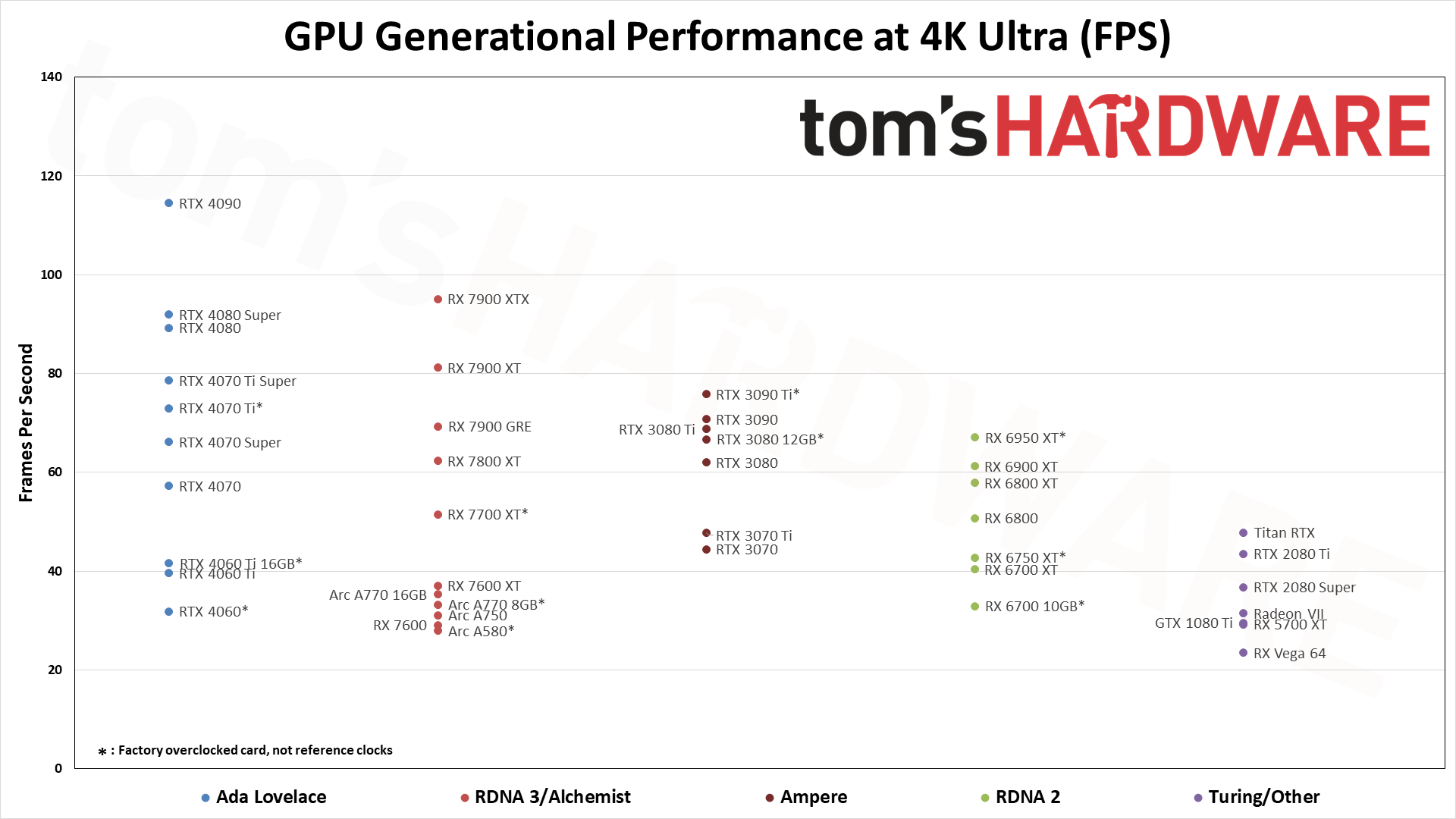With 2025, the new GPU releases have been coming fast and furious. Intel kicked things off with the Arc B580 at the end of 2024, followed by Arc B570 in January. Nvidia announced its Blackwell RTX 50-series architecture at CES 2025, then launched the RTX 5090 and RTX 5080 in late January, with the RTX 5070 Ti in February. The biggest problem with nearly all of thse GPUs? You can’t buy them at MSRP, or sometimes even at all. RTX 5070 along with AMD’s RX 9070 XT and RX 9070 are all slated to arrive in March. Spoiler: Those will all sell out as well.
The real issue is that, by all indications, Nvidia and AMD made some planning errors with the transitions from the prior generation to the new / upcoming hardware. Nearly all of the RTX 40-series GPUs are now basically out of stock, outside of base model RTX 4060 — even the RTX 4060 Ti models are overpriced. And the same goes for AMD’s RX 7000-series, where outside of the RX 7600 / 7600 XT, they’re either drastically overpriced or not available at all.
Inventory ran out before the new GPUs were ready, and that created a backlog of people wanting to upgrade GPUs. Couple that with an inadequate supply of Nvidia’s RTX 50-series cards that have launched and you basically can’t find a reasonably priced graphics card. And then there are new tariffs coming into effect that could further impact prices and availability. It’s a perfect storm hitting the graphics market yet again.
We’re also working on revamping our GPU test suite. We’ve upgraded the test PC to an AMD Ryzen 7 9800X3D and socket AM5 platform, and we’re now in the process of retesting… well, everything, as much as possible. Our latest reviews are using the new test suite and test PC, but we haven’t gotten through enough of the latest and previous generaiton GPUs to swap over to the new data for the hierarchy … yet. That will happen probably next month. In the meantime, all of the existing data is still valid; we just don’t have the results from the new generation GPUs.
Our full GPU hierarchy using traditional rendering (aka, rasterization) comes first, and below that we have our ray tracing GPU benchmarks hierarchy. Those of course require a ray tracing capable GPU so only AMD’s RX 7000/6000-series, Intel’s Arc, and Nvidia’s RTX cards are present. The results are all at native resolution, without enabling DLSS, FSR, or XeSS upscaling or frame generation.
The following tables sort everything solely by our performance-based GPU gaming benchmarks, at 1080p “ultra” for the main suite and at 1080p “medium” for the DXR suite. Factors including price, graphics card power consumption , overall efficiency, and features aren’t factored into the rankings here. The current 2024 results use an Alder Lake Core i9-12900K testbed. Now let’s hit the benchmarks and tables.
For our latest GPU benchmarks, we’ve tested nearly every GPU released in the past seven years, plus some extras, at 1080p medium and 1080p ultra, and sorted the table by the 1080p ultra results. Where it makes sense , we also test at 1440p ultra and 4K ultra. All the scores are scaled relative to the top-ranking 1080p ultra card, which in our suite is the RTX 4090 — especially at 4K and 1440p.
You can also see the above summary chart showing the relative performance of the cards we’ve tested across the past several generations of hardware at 1080p ultra — swipe through the above gallery if you want to see the 1080p medium, 1440p, and 4K ultra images. There are a few missing options (e.g., the GT 1030, RX 550, and several Titan cards), but otherwise it’s basically complete. Note that we also have data in the table below for some of the other older GPUs.
The eight games we’re using for our standard GPU benchmarks hierarchy are Borderlands 3 (DX12), Far Cry 6 (DX12), Flight Simulator (DX11 Nvidia, DX12 AMD/Intel), Forza Horizon 5 (DX12), Horizon Zero Dawn (DX12), Red Dead Redemption 2 (Vulkan), Total War Warhammer 3 (DX11), and Watch Dogs Legion (DX12). The fps score is the geometric mean (equal weighting) of the eight games. Note that the specifications column links directly to our original review for the various GPUs.
GPU Rasterization Hierarchy, Key Takeaways Nvidia RTX 4090 takes the top spot but costs almost twice as much as the second fastest Nvidia card, the RTX 4080 Super . RTX 4090 can encounter CPU bottlenecks at 1440p and especially 1080p.New cards typically match previous gen GPUs that are one or two model tiers “higher” (e.g. RTX 4070 Ti vs. RTX 3090 Ti , or RX 6600 XT vs. RX 5700 XT ). This is not universally true, however (e.g. RX 7800 XT is only slightly faster than the prior 6800 XT). Looking at 1440p, RTX 4080 Super ranks as the most efficient GPU, with other 40-series GPUs rounding out the top ten. AMD’s most efficient GPU is the RX 7900 XTX . Intel’s Arc GPUs rank near the bottom of the chart in terms of efficiency. The best GPU value in FPS per dollar at 1440p is the Arc A580 , followed by the RX 6600 , Arc A750 , RX 6800 , and RTX 4060 . Swipe to scroll horizontally
Graphics Card Lowest Price 1080p Ultra 1080p Medium 1440p Ultra 4K Ultra Specifications (Links to Review) GeForce RTX 4090 $2,529 100.0% (154.1fps) 100.0% (195.7fps) 100.0% (146.1fps) 100.0% (114.5fps) AD102, 16384 shaders, 2520MHz, 24GB GDDR6X@21Gbps, 1008GB/s, 450W Radeon RX 7900 XTX $869 96.7% (149.0fps) 97.2% (190.3fps) 92.6% (135.3fps) 83.1% (95.1fps) Navi 31, 6144 shaders, 2500MHz, 24GB GDDR6@20Gbps, 960GB/s, 355W GeForce RTX 4080 Super No Stock 96.2% (148.3fps) 98.5% (192.7fps) 91.0% (133.0fps) 80.3% (91.9fps) AD103, 10240 shaders, 2550MHz, 16GB GDDR6X@23Gbps, 736GB/s, 320W GeForce RTX 4080 $1,699 95.4% (147.0fps) 98.1% (192.0fps) 89.3% (130.4fps) 78.0% (89.3fps) AD103, 9728 shaders, 2505MHz, 16GB GDDR6X@22.4Gbps, 717GB/s, 320W Radeon RX 7900 XT $649 93.4% (143.9fps) 95.8% (187.6fps) 86.1% (125.9fps) 71.0% (81.2fps) Navi 31, 5376 shaders, 2400MHz, 20GB GDDR6@20Gbps, 800GB/s, 315W GeForce RTX 4070 Ti Super $899 92.3% (142.3fps) 96.8% (189.4fps) 83.5% (122.0fps) 68.7% (78.6fps) AD103, 8448 shaders, 2610MHz, 16GB GDDR6X@21Gbps, 672GB/s, 285W GeForce RTX 4070 Ti $759 89.8% (138.3fps) 95.7% (187.2fps) 79.8% (116.5fps) 63.8% (73.0fps) AD104, 7680 shaders, 2610MHz, 12GB GDDR6X@21Gbps, 504GB/s, 285W Radeon RX 7900 GRE No Stock 88.1% (135.8fps) 94.1% (184.3fps) 78.0% (113.9fps) 60.5% (69.3fps) Navi 31, 5120 shaders, 2245MHz, 16GB GDDR6@18Gbps, 576GB/s, 260W GeForce RTX 4070 Super $609 87.1% (134.2fps) 94.6% (185.1fps) 75.2% (109.8fps) 57.8% (66.1fps) AD104, 7168 shaders, 2475MHz, 12GB GDDR6X@21Gbps, 504GB/s, 220W Radeon RX 6950 XT $859 84.7% (130.5fps) 91.7% (179.4fps) 75.3% (110.1fps) 58.6% (67.1fps) Navi 21, 5120 shaders, 2310MHz, 16GB GDDR6@18Gbps, 576GB/s, 335W GeForce RTX 3090 Ti $1,899 84.7% (130.5fps) 90.5% (177.1fps) 77.1% (112.7fps) 66.3% (75.9fps) GA102, 10752 shaders, 1860MHz, 24GB GDDR6X@21Gbps, 1008GB/s, 450W Radeon RX 7800 XT $489 83.9% (129.3fps) 91.5% (179.1fps) 72.4% (105.8fps) 54.4% (62.3fps) Navi 32, 3840 shaders, 2430MHz, 16GB GDDR6@19.5Gbps, 624GB/s, 263W GeForce RTX 3090 $1,530 81.4% (125.5fps) 88.9% (174.0fps) 72.5% (106.0fps) 61.8% (70.7fps) GA102, 10496 shaders, 1695MHz, 24GB GDDR6X@19.5Gbps, 936GB/s, 350W Radeon RX 6900 XT $810 80.9% (124.6fps) 89.6% (175.3fps) 69.9% (102.1fps) 53.5% (61.2fps) Navi 21, 5120 shaders, 2250MHz, 16GB GDDR6@16Gbps, 512GB/s, 300W GeForce RTX 3080 Ti $979 80.4% (123.9fps) 87.8% (171.8fps) 71.1% (103.9fps) 60.1% (68.8fps) GA102, 10240 shaders, 1665MHz, 12GB GDDR6X@19Gbps, 912GB/s, 350W Radeon RX 6800 XT $1,150 79.6% (122.7fps) 88.5% (173.2fps) 67.8% (99.0fps) 50.6% (57.9fps) Navi 21, 4608 shaders, 2250MHz, 16GB GDDR6@16Gbps, 512GB/s, 300W GeForce RTX 3080 12GB $829 79.2% (122.1fps) 86.5% (169.4fps) 70.0% (102.3fps) 58.3% (66.7fps) GA102, 8960 shaders, 1845MHz, 12GB GDDR6X@19Gbps, 912GB/s, 400W GeForce RTX 4070 $549 79.2% (122.0fps) 90.7% (177.5fps) 66.9% (97.8fps) 50.0% (57.2fps) AD104, 5888 shaders, 2475MHz, 12GB GDDR6X@21Gbps, 504GB/s, 200W GeForce RTX 3080 $788 76.0% (117.0fps) 85.6% (167.6fps) 66.0% (96.4fps) 54.1% (62.0fps) GA102, 8704 shaders, 1710MHz, 10GB GDDR6X@19Gbps, 760GB/s, 320W Radeon RX 7700 XT $409 75.3% (116.1fps) 87.7% (171.6fps) 63.4% (92.7fps) 45.0% (51.5fps) Navi 32, 3456 shaders, 2544MHz, 12GB GDDR6@18Gbps, 432GB/s, 245W Radeon RX 6800 $849 74.4% (114.6fps) 86.2% (168.7fps) 61.0% (89.2fps) 44.3% (50.7fps) Navi 21, 3840 shaders, 2105MHz, 16GB GDDR6@16Gbps, 512GB/s, 250W GeForce RTX 3070 Ti $699 67.5% (104.0fps) 81.6% (159.8fps) 56.7% (82.8fps) 41.7% (47.7fps) GA104, 6144 shaders, 1770MHz, 8GB GDDR6X@19Gbps, 608GB/s, 290W Radeon RX 6750 XT $354 66.8% (102.9fps) 82.6% (161.6fps) 52.9% (77.2fps) 37.4% (42.8fps) Navi 22, 2560 shaders, 2600MHz, 12GB GDDR6@18Gbps, 432GB/s, 250W GeForce RTX 4060 Ti 16GB $634 65.3% (100.6fps) 82.6% (161.7fps) 51.8% (75.7fps) 36.4% (41.6fps) AD106, 4352 shaders, 2535MHz, 16GB GDDR6@18Gbps, 288GB/s, 160W GeForce RTX 4060 Ti $399 65.1% (100.4fps) 81.8% (160.1fps) 51.7% (75.6fps) 34.6% (39.6fps) AD106, 4352 shaders, 2535MHz, 8GB GDDR6@18Gbps, 288GB/s, 160W Titan RTX Row 25 – Cell 1 64.5% (99.3fps) 80.0% (156.6fps) 54.4% (79.5fps) 41.8% (47.8fps) TU102, 4608 shaders, 1770MHz, 24GB GDDR6@14Gbps, 672GB/s, 280W Radeon RX 6700 XT $499 64.3% (99.1fps) 80.8% (158.1fps) 50.3% (73.4fps) 35.3% (40.4fps) Navi 22, 2560 shaders, 2581MHz, 12GB GDDR6@16Gbps, 384GB/s, 230W GeForce RTX 3070 $495 64.1% (98.8fps) 79.1% (154.8fps) 53.2% (77.7fps) 38.8% (44.4fps) GA104, 5888 shaders, 1725MHz, 8GB GDDR6@14Gbps, 448GB/s, 220W GeForce RTX 2080 Ti Row 28 – Cell 1 62.5% (96.3fps) 77.2% (151.0fps) 51.8% (75.6fps) 38.0% (43.5fps) TU102, 4352 shaders, 1545MHz, 11GB GDDR6@14Gbps, 616GB/s, 250W Radeon RX 7600 XT $314 59.7% (91.9fps) 77.3% (151.2fps) 45.1% (65.9fps) 32.4% (37.1fps) Navi 33, 2048 shaders, 2755MHz, 16GB GDDR6@18Gbps, 288GB/s, 190W GeForce RTX 3060 Ti $498 58.9% (90.7fps) 75.0% (146.9fps) 47.9% (70.0fps) Row 30 – Cell 5 GA104, 4864 shaders, 1665MHz, 8GB GDDR6@14Gbps, 448GB/s, 200W Radeon RX 6700 10GB No Stock 55.9% (86.1fps) 74.4% (145.7fps) 43.0% (62.8fps) 28.7% (32.9fps) Navi 22, 2304 shaders, 2450MHz, 10GB GDDR6@16Gbps, 320GB/s, 175W GeForce RTX 2080 Super Row 32 – Cell 1 55.8% (86.0fps) 72.2% (141.3fps) 45.2% (66.1fps) 32.1% (36.7fps) TU104, 3072 shaders, 1815MHz, 8GB GDDR6@15.5Gbps, 496GB/s, 250W GeForce RTX 4060 $294 55.1% (84.9fps) 72.7% (142.3fps) 41.9% (61.2fps) 27.8% (31.9fps) AD107, 3072 shaders, 2460MHz, 8GB GDDR6@17Gbps, 272GB/s, 115W GeForce RTX 2080 Row 34 – Cell 1 53.5% (82.5fps) 69.8% (136.7fps) 43.2% (63.2fps) Row 34 – Cell 5 TU104, 2944 shaders, 1710MHz, 8GB GDDR6@14Gbps, 448GB/s, 215W Radeon RX 7600 $259 53.2% (82.0fps) 72.3% (141.4fps) 39.2% (57.3fps) 25.4% (29.1fps) Navi 33, 2048 shaders, 2655MHz, 8GB GDDR6@18Gbps, 288GB/s, 165W Radeon RX 6650 XT $254 50.4% (77.7fps) 70.0% (137.1fps) 37.3% (54.5fps) Row 36 – Cell 5 Navi 23, 2048 shaders, 2635MHz, 8GB GDDR6@18Gbps, 280GB/s, 180W GeForce RTX 2070 Super Row 37 – Cell 1 50.3% (77.4fps) 66.2% (129.6fps) 40.0% (58.4fps) Row 37 – Cell 5 TU104, 2560 shaders, 1770MHz, 8GB GDDR6@14Gbps, 448GB/s, 215W Intel Arc A770 16GB $299 49.9% (76.9fps) 59.4% (116.4fps) 41.0% (59.8fps) 30.8% (35.3fps) ACM-G10, 4096 shaders, 2400MHz, 16GB GDDR6@17.5Gbps, 560GB/s, 225W Intel Arc A770 8GB No Stock 48.9% (75.3fps) 59.0% (115.5fps) 39.3% (57.5fps) 29.0% (33.2fps) ACM-G10, 4096 shaders, 2400MHz, 8GB GDDR6@16Gbps, 512GB/s, 225W Radeon RX 6600 XT $259 48.5% (74.7fps) 68.2% (133.5fps) 35.7% (52.2fps) Row 40 – Cell 5 Navi 23, 2048 shaders, 2589MHz, 8GB GDDR6@16Gbps, 256GB/s, 160W Radeon RX 5700 XT Row 41 – Cell 1 47.6% (73.3fps) 63.8% (124.9fps) 36.3% (53.1fps) 25.6% (29.3fps) Navi 10, 2560 shaders, 1905MHz, 8GB GDDR6@14Gbps, 448GB/s, 225W GeForce RTX 3060 Row 42 – Cell 1 46.9% (72.3fps) 61.8% (121.0fps) 36.9% (54.0fps) Row 42 – Cell 5 GA106, 3584 shaders, 1777MHz, 12GB GDDR6@15Gbps, 360GB/s, 170W Intel Arc A750 $239 45.9% (70.8fps) 56.4% (110.4fps) 36.7% (53.7fps) 27.2% (31.1fps) ACM-G10, 3584 shaders, 2350MHz, 8GB GDDR6@16Gbps, 512GB/s, 225W GeForce RTX 2070 Row 44 – Cell 1 45.3% (69.8fps) 60.8% (119.1fps) 35.5% (51.8fps) Row 44 – Cell 5 TU106, 2304 shaders, 1620MHz, 8GB GDDR6@14Gbps, 448GB/s, 175W Radeon VII Row 45 – Cell 1 45.1% (69.5fps) 58.2% (113.9fps) 36.3% (53.0fps) 27.5% (31.5fps) Vega 20, 3840 shaders, 1750MHz, 16GB HBM2@2.0Gbps, 1024GB/s, 300W GeForce GTX 1080 Ti Row 46 – Cell 1 43.1% (66.4fps) 56.3% (110.2fps) 34.4% (50.2fps) 25.8% (29.5fps) GP102, 3584 shaders, 1582MHz, 11GB GDDR5X@11Gbps, 484GB/s, 250W GeForce RTX 2060 Super Row 47 – Cell 1 42.5% (65.5fps) 57.2% (112.0fps) 33.1% (48.3fps) Row 47 – Cell 5 TU106, 2176 shaders, 1650MHz, 8GB GDDR6@14Gbps, 448GB/s, 175W Radeon RX 6600 $189 42.3% (65.2fps) 59.3% (116.2fps) 30.6% (44.8fps) Row 48 – Cell 5 Navi 23, 1792 shaders, 2491MHz, 8GB GDDR6@14Gbps, 224GB/s, 132W Intel Arc A580 $169 42.3% (65.1fps) 51.6% (101.1fps) 33.4% (48.8fps) 24.4% (27.9fps) ACM-G10, 3072 shaders, 2300MHz, 8GB GDDR6@16Gbps, 512GB/s, 185W Radeon RX 5700 Row 50 – Cell 1 41.9% (64.5fps) 56.6% (110.8fps) 31.9% (46.7fps) Row 50 – Cell 5 Navi 10, 2304 shaders, 1725MHz, 8GB GDDR6@14Gbps, 448GB/s, 180W Radeon RX 5600 XT Row 51 – Cell 1 37.5% (57.8fps) 51.1% (100.0fps) 28.8% (42.0fps) Row 51 – Cell 5 Navi 10, 2304 shaders, 1750MHz, 8GB GDDR6@14Gbps, 336GB/s, 160W Radeon RX Vega 64 Row 52 – Cell 1 36.8% (56.7fps) 48.2% (94.3fps) 28.5% (41.6fps) 20.5% (23.5fps) Vega 10, 4096 shaders, 1546MHz, 8GB HBM2@1.89Gbps, 484GB/s, 295W GeForce RTX 2060 Row 53 – Cell 1 36.0% (55.5fps) 51.4% (100.5fps) 27.5% (40.1fps) Row 53 – Cell 5 TU106, 1920 shaders, 1680MHz, 6GB GDDR6@14Gbps, 336GB/s, 160W GeForce GTX 1080 Row 54 – Cell 1 34.4% (53.0fps) 45.9% (89.9fps) 27.0% (39.4fps) Row 54 – Cell 5 GP104, 2560 shaders, 1733MHz, 8GB GDDR5X@10Gbps, 320GB/s, 180W GeForce RTX 3050 $169 33.7% (51.9fps) 45.4% (88.8fps) 26.4% (38.5fps) Row 55 – Cell 5 GA106, 2560 shaders, 1777MHz, 8GB GDDR6@14Gbps, 224GB/s, 130W GeForce GTX 1070 Ti Row 56 – Cell 1 33.1% (51.1fps) 43.8% (85.7fps) 26.0% (37.9fps) Row 56 – Cell 5 GP104, 2432 shaders, 1683MHz, 8GB GDDR5@8Gbps, 256GB/s, 180W Radeon RX Vega 56 Row 57 – Cell 1 32.8% (50.6fps) 43.0% (84.2fps) 25.3% (37.0fps) Row 57 – Cell 5 Vega 10, 3584 shaders, 1471MHz, 8GB HBM2@1.6Gbps, 410GB/s, 210W GeForce GTX 1660 Super Row 58 – Cell 1 30.3% (46.8fps) 43.7% (85.5fps) 22.8% (33.3fps) Row 58 – Cell 5 TU116, 1408 shaders, 1785MHz, 6GB GDDR6@14Gbps, 336GB/s, 125W GeForce GTX 1660 Ti Row 59 – Cell 1 30.3% (46.6fps) 43.3% (84.8fps) 22.8% (33.3fps) Row 59 – Cell 5 TU116, 1536 shaders, 1770MHz, 6GB GDDR6@12Gbps, 288GB/s, 120W GeForce GTX 1070 Row 60 – Cell 1 29.0% (44.7fps) 38.3% (75.0fps) 22.7% (33.1fps) Row 60 – Cell 5 GP104, 1920 shaders, 1683MHz, 8GB GDDR5@8Gbps, 256GB/s, 150W GeForce GTX 1660 Row 61 – Cell 1 27.7% (42.6fps) 39.7% (77.8fps) 20.8% (30.3fps) Row 61 – Cell 5 TU116, 1408 shaders, 1785MHz, 6GB GDDR5@8Gbps, 192GB/s, 120W Radeon RX 5500 XT 8GB Row 62 – Cell 1 25.7% (39.7fps) 36.8% (72.1fps) 19.3% (28.2fps) Row 62 – Cell 5 Navi 14, 1408 shaders, 1845MHz, 8GB GDDR6@14Gbps, 224GB/s, 130W Radeon RX 590 Row 63 – Cell 1 25.5% (39.3fps) 35.0% (68.5fps) 19.9% (29.0fps) Row 63 – Cell 5 Polaris 30, 2304 shaders, 1545MHz, 8GB GDDR5@8Gbps, 256GB/s, 225W GeForce GTX 980 Ti Row 64 – Cell 1 23.3% (35.9fps) 32.0% (62.6fps) 18.2% (26.6fps) Row 64 – Cell 5 GM200, 2816 shaders, 1075MHz, 6GB GDDR5@7Gbps, 336GB/s, 250W Radeon RX 580 8GB Row 65 – Cell 1 22.9% (35.3fps) 31.5% (61.7fps) 17.8% (26.0fps) Row 65 – Cell 5 Polaris 20, 2304 shaders, 1340MHz, 8GB GDDR5@8Gbps, 256GB/s, 185W Radeon R9 Fury X Row 66 – Cell 1 22.9% (35.2fps) 32.6% (63.8fps) Row 66 – Cell 4 Row 66 – Cell 5 Fiji, 4096 shaders, 1050MHz, 4GB HBM2@2Gbps, 512GB/s, 275W GeForce GTX 1650 Super Row 67 – Cell 1 22.0% (33.9fps) 34.6% (67.7fps) 14.5% (21.2fps) Row 67 – Cell 5 TU116, 1280 shaders, 1725MHz, 4GB GDDR6@12Gbps, 192GB/s, 100W Radeon RX 5500 XT 4GB Row 68 – Cell 1 21.6% (33.3fps) 34.1% (66.8fps) Row 68 – Cell 4 Row 68 – Cell 5 Navi 14, 1408 shaders, 1845MHz, 4GB GDDR6@14Gbps, 224GB/s, 130W GeForce GTX 1060 6GB Row 69 – Cell 1 20.8% (32.1fps) 29.5% (57.7fps) 15.8% (23.0fps) Row 69 – Cell 5 GP106, 1280 shaders, 1708MHz, 6GB GDDR5@8Gbps, 192GB/s, 120W Radeon RX 6500 XT $232 19.9% (30.6fps) 33.6% (65.8fps) 12.3% (18.0fps) Row 70 – Cell 5 Navi 24, 1024 shaders, 2815MHz, 4GB GDDR6@18Gbps, 144GB/s, 107W Radeon R9 390 Row 71 – Cell 1 19.3% (29.8fps) 26.1% (51.1fps) Row 71 – Cell 4 Row 71 – Cell 5 Grenada, 2560 shaders, 1000MHz, 8GB GDDR5@6Gbps, 384GB/s, 275W GeForce GTX 980 Row 72 – Cell 1 18.7% (28.9fps) 27.4% (53.6fps) Row 72 – Cell 4 Row 72 – Cell 5 GM204, 2048 shaders, 1216MHz, 4GB GDDR5@7Gbps, 256GB/s, 165W GeForce GTX 1650 GDDR6 Row 73 – Cell 1 18.7% (28.8fps) 28.9% (56.6fps) Row 73 – Cell 4 Row 73 – Cell 5 TU117, 896 shaders, 1590MHz, 4GB GDDR6@12Gbps, 192GB/s, 75W Intel Arc A380 $119 18.4% (28.4fps) 27.7% (54.3fps) 13.3% (19.5fps) Row 74 – Cell 5 ACM-G11, 1024 shaders, 2450MHz, 6GB GDDR6@15.5Gbps, 186GB/s, 75W Radeon RX 570 4GB Row 75 – Cell 1 18.2% (28.1fps) 27.4% (53.6fps) 13.6% (19.9fps) Row 75 – Cell 5 Polaris 20, 2048 shaders, 1244MHz, 4GB GDDR5@7Gbps, 224GB/s, 150W GeForce GTX 1650 Row 76 – Cell 1 17.5% (27.0fps) 26.2% (51.3fps) Row 76 – Cell 4 Row 76 – Cell 5 TU117, 896 shaders, 1665MHz, 4GB GDDR5@8Gbps, 128GB/s, 75W GeForce GTX 970 Row 77 – Cell 1 17.2% (26.5fps) 25.0% (49.0fps) Row 77 – Cell 4 Row 77 – Cell 5 GM204, 1664 shaders, 1178MHz, 4GB GDDR5@7Gbps, 256GB/s, 145W Radeon RX 6400 $209 15.7% (24.1fps) 26.1% (51.1fps) Row 78 – Cell 4 Row 78 – Cell 5 Navi 24, 768 shaders, 2321MHz, 4GB GDDR6@16Gbps, 128GB/s, 53W GeForce GTX 1050 Ti Row 79 – Cell 1 12.9% (19.8fps) 19.4% (38.0fps) Row 79 – Cell 4 Row 79 – Cell 5 GP107, 768 shaders, 1392MHz, 4GB GDDR5@7Gbps, 112GB/s, 75W GeForce GTX 1060 3GB Row 80 – Cell 1 Row 80 – Cell 2 26.8% (52.5fps) Row 80 – Cell 4 Row 80 – Cell 5 GP106, 1152 shaders, 1708MHz, 3GB GDDR5@8Gbps, 192GB/s, 120W GeForce GTX 1630 Row 81 – Cell 1 10.9% (16.9fps) 17.3% (33.8fps) Row 81 – Cell 4 Row 81 – Cell 5 TU117, 512 shaders, 1785MHz, 4GB GDDR6@12Gbps, 96GB/s, 75W Radeon RX 560 4GB Row 82 – Cell 1 9.6% (14.7fps) 16.2% (31.7fps) Row 82 – Cell 4 Row 82 – Cell 5 Baffin, 1024 shaders, 1275MHz, 4GB GDDR5@7Gbps, 112GB/s, 60-80W GeForce GTX 1050 Row 83 – Cell 1 Row 83 – Cell 2 15.2% (29.7fps) Row 83 – Cell 4 Row 83 – Cell 5 GP107, 640 shaders, 1455MHz, 2GB GDDR5@7Gbps, 112GB/s, 75W Radeon RX 550 4GB Row 84 – Cell 1 Row 84 – Cell 2 10.0% (19.5fps) Row 84 – Cell 4 Row 84 – Cell 5 Lexa, 640 shaders, 1183MHz, 4GB GDDR5@7Gbps, 112GB/s, 50W GeForce GT 1030 Row 85 – Cell 1 Row 85 – Cell 2 7.5% (14.6fps) Row 85 – Cell 4 Row 85 – Cell 5 GP108, 384 shaders, 1468MHz, 2GB GDDR5@6Gbps, 48GB/s, 30W
*: GPU couldn’t run all tests, so the overall score is slightly skewed at 1080p ultra.
While the RTX 4090 does technically take first place at 1080p ultra, it’s the 1440p and especially 4K numbers that impress. It’s less than 2% faster than the RTX 4080 Super at 1080p ultra, but that increases to 9% at 1440p and then 25% at 4K. Also note that the fps numbers in our table incorporate both the average and minimum fps into a single score — with the average given more weight than the 1% low fps.
Again, keep in mind that we’re not including any ray tracing or DLSS results in the above table, as we use the same test suite with the same settings on all current and previous generation graphics cards. Since only RTX cards support DLSS (and RTX 40-series if you want DLSS 3), that would drastically limit which cards we could directly compare. You can see DLSS 2/3 and FSR 2 upscaling results in our RTX 4070 review if you want to check out how the various upscaling modes can help.
The RTX 4090 comes at a steep price, though it’s not that much worse than the previous generation RTX 3090 . In fact, we’d say it’s a lot better in some respects, as the 3090 was only a minor improvement in performance compared to the 3080 at the time of launch, but with more than double the VRAM. Nvidia pulled out all the stops with the 4090, increasing the core counts, clock speeds, and power limits to push it beyond all contenders. There are two problems with the 4090, however: It’s not available at MSRP any longer, due to demand from the AI sector — it often costs $2,000 or more — and there are still concerns with pulling 450W of power over the 16-pin connector.
Stepping down from the RTX 4090, the RTX 4080 Super and RX 7900 XTX trade blows at higher resolutions, while CPU bottlenecks come into play at 1080p. We’ll be switching our testbed in the near future, with the current results from our 13900K testing in the charts at the bottom of the page.
(Image credit: Intel) Outside of the latest releases from AMD and Nvidia, the RX 6000- and RTX 30-series chips still perform reasonably well and if you’re using such a card, there may not be any need to upgrade at present. Intel’s Arc GPUs also fall into this category and are something of a wild card.
We’ve been testing and retesting GPUs periodically, and the Arc chips running the latest drivers now complete all of our benchmarks without any major anomalies. (Minecraft was previously a problem, though Intel has finally sorted that out.) They’re not great on efficiency, but overall performance and pricing for the A750 is quite good.
Turning to the previous generation GPUs, the RTX 20-series and GTX 16-series chips end up scattered throughout the results, along with the RX 5000-series . The general rule of thumb is that you get one or two “model upgrades” with the newer architectures, so for example the RTX 2080 Super comes in just below the RTX 3060 Ti, while the RX 5700 XT basically matches the newer and less expensive RX 6600 XT.
Go back far enough and you can see how modern games at ultra settings severely punish cards that don’t have more than 4GB VRAM. We’ve been saying for a few years now that 4GB was just scraping by, and these days we’d avoid buying anything with less than 8GB of VRAM — 12GB or more is the minimum we’d want with a mainstream GPU, and 16GB or more for high-end and above. Old cards like the GTX 1060 3GB and GTX 1050 actually failed to run some of our tests, which skews their results a bit, even though they do better at 1080p medium.
Now let’s switch over to the ray tracing hierarchy.
(Image credit: Techland) Ray Tracing GPU Benchmarks Ranking 2025 Enabling ray tracing, particularly with demanding games like many of those we’re using in our DXR test suite, can cause framerates to drop off a cliff. We’re testing with “medium” and “ultra” ray tracing settings. Medium generally means using the medium graphics preset but turning on ray tracing effects (set to “medium” if that’s an option; otherwise, “on”), while ultra turns on all of the RT options at more or less maximum quality.
Because ray tracing is so much more demanding, we’re sorting these results by the 1080p medium scores. That’s also because the RX 6500 XT , RX 6400 , and Arc A380 basically can’t handle ray tracing even at these settings, and testing at anything more than 1080p medium would be fruitless (though we’ve done 1080p ultra just for fun if you check the charts at the end).
The five ray tracing games we’re using are Bright Memory Infinite , Control Ultimate Edition , Cyberpunk 2077 , Metro Exodus Enhanced , and Minecraft — all of these use the DirectX 12 / DX12 Ultimate API. The fps score is the geometric mean (equal weighting) of the five games, and the percentage is scaled relative to the fastest GPU in the list, which again is the GeForce RTX 4090.
If you want to see what the future may hold with ray tracing, check out our Alan Wake 2 benchmarksextremely limited. For most games, we still feel running pure rasterization rendering makes more sense.
Image 1 of 4
(Image credit: Tom’s Hardware)
(Image credit: Tom’s Hardware)
(Image credit: Tom’s Hardware)
(Image credit: Tom’s Hardware)
GPU Ray Tracing Hierarchy, Key Takeaways Nvidia absolutely dominates in ray tracing performance, with the RTX 4070 Super and above taking down AMD’s best AMD RX 7900 XTX , which sits at position 11. Intel’s Arc A770 lands at number 31. DLSS 2 upscaling with quality mode is supported in most ray tracing games and can boost performance an additional 30~50 percent (depending on the game, resolution, and settings used). FSR 2/3 and XeSS support can provide a similar uplift, but FSR 2 is only in about a third as many games right now, and XeSS and FSR 3 support are even less common. You’ll need an RTX 4070 or RTX 3080 or faster GPU to handle 1080p with maxed out settings at 60 fps or more, which also means Performance mode upscaling can make 4K viable. RTX 4080 again ranks as the most efficient GPU, followed by the rest of the 40-series cards. Even the RTX 3060, 3060 Ti, and 3070 rank ahead of AMD’s best for efficiency, which is the RX 7900 XT . Intel’s Arc GPUs are still pretty far down the efficiency list, though in DXR they’re often better than AMD’s RX 6000-series parts.The best overall ray tracing “value” in FPS per dollar (at 1080p ultra) goes to the Arc A580 , followed by the RTX 4060 , RTX 4070 , Arc A750 , and RTX 4060 Ti . Swipe to scroll horizontally
Graphics Card Lowest Price 1080p Medium 1080p Ultra 1440p Ultra 4K Ultra Specifications (Links to Review) GeForce RTX 4090 $2,643 100.0% (165.9fps) 100.0% (136.3fps) 100.0% (103.9fps) 100.0% (55.9fps) AD102, 16384 shaders, 2520MHz, 24GB GDDR6X@21Gbps, 1008GB/s, 450W GeForce RTX 4080 Super No Stock 86.8% (144.0fps) 85.3% (116.3fps) 75.6% (78.6fps) 70.5% (39.4fps) AD103, 10240 shaders, 2550MHz, 16GB GDDR6X@23Gbps, 736GB/s, 320W GeForce RTX 4080 $1,725 85.4% (141.6fps) 83.4% (113.6fps) 73.1% (76.0fps) 67.7% (37.8fps) AD103, 9728 shaders, 2505MHz, 16GB GDDR6X@22.4Gbps, 717GB/s, 320W GeForce RTX 4070 Ti Super $819 77.3% (128.2fps) 73.5% (100.3fps) 63.5% (66.0fps) 58.4% (32.6fps) AD103, 8448 shaders, 2610MHz, 16GB GDDR6X@21Gbps, 672GB/s, 285W GeForce RTX 3090 Ti $1,899 71.9% (119.3fps) 68.4% (93.2fps) 59.6% (62.0fps) 56.9% (31.8fps) GA102, 10752 shaders, 1860MHz, 24GB GDDR6X@21Gbps, 1008GB/s, 450W GeForce RTX 4070 Ti $739 71.5% (118.6fps) 67.1% (91.6fps) 56.9% (59.1fps) 52.3% (29.2fps) AD104, 7680 shaders, 2610MHz, 12GB GDDR6X@21Gbps, 504GB/s, 285W GeForce RTX 4070 Super $609 68.1% (113.0fps) 62.7% (85.6fps) 52.4% (54.5fps) 47.8% (26.7fps) AD104, 7168 shaders, 2475MHz, 12GB GDDR6X@21Gbps, 504GB/s, 220W GeForce RTX 3090 $1,389 67.7% (112.4fps) 63.5% (86.6fps) 55.1% (57.2fps) 51.8% (28.9fps) GA102, 10496 shaders, 1695MHz, 24GB GDDR6X@19.5Gbps, 936GB/s, 350W GeForce RTX 3080 Ti $979 66.5% (110.4fps) 62.2% (84.8fps) 53.2% (55.3fps) 48.6% (27.1fps) GA102, 10240 shaders, 1665MHz, 12GB GDDR6X@19Gbps, 912GB/s, 350W Radeon RX 7900 XTX $869 66.1% (109.6fps) 61.7% (84.1fps) 53.2% (55.3fps) 48.6% (27.2fps) Navi 31, 6144 shaders, 2500MHz, 24GB GDDR6@20Gbps, 960GB/s, 355W GeForce RTX 3080 12GB $829 64.9% (107.6fps) 59.9% (81.7fps) 50.8% (52.8fps) 46.3% (25.8fps) GA102, 8960 shaders, 1845MHz, 12GB GDDR6X@19Gbps, 912GB/s, 400W GeForce RTX 4070 $519 61.2% (101.4fps) 54.2% (73.9fps) 45.1% (46.9fps) 40.7% (22.7fps) AD104, 5888 shaders, 2475MHz, 12GB GDDR6X@21Gbps, 504GB/s, 200W Radeon RX 7900 XT $689 60.4% (100.3fps) 55.3% (75.3fps) 46.7% (48.5fps) 41.6% (23.3fps) Navi 31, 5376 shaders, 2400MHz, 20GB GDDR6@20Gbps, 800GB/s, 315W GeForce RTX 3080 $829 60.2% (99.8fps) 54.5% (74.3fps) 46.1% (47.9fps) 41.8% (23.3fps) GA102, 8704 shaders, 1710MHz, 10GB GDDR6X@19Gbps, 760GB/s, 320W Radeon RX 7900 GRE No Stock 52.9% (87.7fps) 46.8% (63.7fps) 39.6% (41.2fps) 35.7% (19.9fps) Navi 31, 5120 shaders, 2245MHz, 16GB GDDR6@18Gbps, 576GB/s, 260W GeForce RTX 3070 Ti $499 50.6% (84.0fps) 43.0% (58.6fps) 35.7% (37.1fps) Row 15 – Cell 5 GA104, 6144 shaders, 1770MHz, 8GB GDDR6X@19Gbps, 608GB/s, 290W Radeon RX 6950 XT $1,199 48.3% (80.1fps) 41.4% (56.4fps) 34.3% (35.7fps) 31.0% (17.3fps) Navi 21, 5120 shaders, 2310MHz, 16GB GDDR6@18Gbps, 576GB/s, 335W GeForce RTX 3070 $399 47.2% (78.2fps) 39.9% (54.4fps) 32.8% (34.1fps) Row 17 – Cell 5 GA104, 5888 shaders, 1725MHz, 8GB GDDR6@14Gbps, 448GB/s, 220W Radeon RX 7800 XT $489 46.7% (77.5fps) 41.9% (57.1fps) 34.9% (36.3fps) 31.0% (17.3fps) Navi 32, 3840 shaders, 2430MHz, 16GB GDDR6@19.5Gbps, 624GB/s, 263W Radeon RX 6900 XT $811 45.4% (75.4fps) 38.3% (52.3fps) 32.1% (33.3fps) 28.8% (16.1fps) Navi 21, 5120 shaders, 2250MHz, 16GB GDDR6@16Gbps, 512GB/s, 300W GeForce RTX 4060 Ti $399 45.2% (75.1fps) 38.7% (52.8fps) 32.3% (33.5fps) 24.8% (13.9fps) AD106, 4352 shaders, 2535MHz, 8GB GDDR6@18Gbps, 288GB/s, 160W GeForce RTX 4060 Ti 16GB $449 45.2% (75.0fps) 38.8% (53.0fps) 32.7% (34.0fps) 29.5% (16.5fps) AD106, 4352 shaders, 2535MHz, 16GB GDDR6@18Gbps, 288GB/s, 160W Titan RTX Row 22 – Cell 1 44.8% (74.4fps) 39.1% (53.3fps) 33.7% (35.0fps) 31.2% (17.4fps) TU102, 4608 shaders, 1770MHz, 24GB GDDR6@14Gbps, 672GB/s, 280W GeForce RTX 2080 Ti Row 23 – Cell 1 42.7% (70.9fps) 37.2% (50.7fps) 31.6% (32.9fps) Row 23 – Cell 5 TU102, 4352 shaders, 1545MHz, 11GB GDDR6@14Gbps, 616GB/s, 250W Radeon RX 6800 XT $1,099 42.2% (70.0fps) 35.6% (48.5fps) 29.9% (31.1fps) 26.8% (15.0fps) Navi 21, 4608 shaders, 2250MHz, 16GB GDDR6@16Gbps, 512GB/s, 300W GeForce RTX 3060 Ti $453 41.9% (69.5fps) 35.0% (47.7fps) 28.8% (30.0fps) Row 25 – Cell 5 GA104, 4864 shaders, 1665MHz, 8GB GDDR6@14Gbps, 448GB/s, 200W Radeon RX 7700 XT $404 41.3% (68.4fps) 36.5% (49.7fps) 30.6% (31.8fps) 27.2% (15.2fps) Navi 32, 3456 shaders, 2544MHz, 12GB GDDR6@18Gbps, 432GB/s, 245W Radeon RX 6800 $849 36.3% (60.1fps) 30.2% (41.2fps) 25.4% (26.3fps) Row 27 – Cell 5 Navi 21, 3840 shaders, 2105MHz, 16GB GDDR6@16Gbps, 512GB/s, 250W GeForce RTX 2080 Super Row 28 – Cell 1 35.8% (59.4fps) 30.8% (42.0fps) 26.1% (27.1fps) Row 28 – Cell 5 TU104, 3072 shaders, 1815MHz, 8GB GDDR6@15.5Gbps, 496GB/s, 250W GeForce RTX 4060 $294 35.4% (58.8fps) 30.6% (41.7fps) 24.9% (25.8fps) Row 29 – Cell 5 AD107, 3072 shaders, 2460MHz, 8GB GDDR6@17Gbps, 272GB/s, 115W GeForce RTX 2080 Row 30 – Cell 1 34.4% (57.1fps) 29.1% (39.7fps) 24.6% (25.5fps) Row 30 – Cell 5 TU104, 2944 shaders, 1710MHz, 8GB GDDR6@14Gbps, 448GB/s, 215W Intel Arc A770 8GB No Stock 32.7% (54.2fps) 28.4% (38.7fps) 24.0% (24.9fps) Row 31 – Cell 5 ACM-G10, 4096 shaders, 2400MHz, 8GB GDDR6@16Gbps, 512GB/s, 225W Intel Arc A770 16GB $299 32.6% (54.1fps) 28.3% (38.6fps) 25.3% (26.2fps) Row 32 – Cell 5 ACM-G10, 4096 shaders, 2400MHz, 16GB GDDR6@17.5Gbps, 560GB/s, 225W GeForce RTX 3060 Row 33 – Cell 1 31.7% (52.5fps) 25.7% (35.1fps) 21.1% (22.0fps) Row 33 – Cell 5 GA106, 3584 shaders, 1777MHz, 12GB GDDR6@15Gbps, 360GB/s, 170W GeForce RTX 2070 Super Row 34 – Cell 1 31.6% (52.4fps) 26.8% (36.6fps) 22.3% (23.1fps) Row 34 – Cell 5 TU104, 2560 shaders, 1770MHz, 8GB GDDR6@14Gbps, 448GB/s, 215W Intel Arc A750 $189 30.7% (51.0fps) 26.8% (36.6fps) 22.6% (23.5fps) Row 35 – Cell 5 ACM-G10, 3584 shaders, 2350MHz, 8GB GDDR6@16Gbps, 512GB/s, 225W Radeon RX 6750 XT $359 30.0% (49.8fps) 25.3% (34.5fps) 20.7% (21.5fps) Row 36 – Cell 5 Navi 22, 2560 shaders, 2600MHz, 12GB GDDR6@18Gbps, 432GB/s, 250W Radeon RX 6700 XT $519 28.1% (46.6fps) 23.7% (32.3fps) 19.1% (19.9fps) Row 37 – Cell 5 Navi 22, 2560 shaders, 2581MHz, 12GB GDDR6@16Gbps, 384GB/s, 230W GeForce RTX 2070 Row 38 – Cell 1 27.9% (46.3fps) 23.5% (32.1fps) 19.7% (20.4fps) Row 38 – Cell 5 TU106, 2304 shaders, 1620MHz, 8GB GDDR6@14Gbps, 448GB/s, 175W Intel Arc A580 $169 27.5% (45.6fps) 24.0% (32.7fps) 20.3% (21.1fps) Row 39 – Cell 5 ACM-G10, 3072 shaders, 2300MHz, 8GB GDDR6@16Gbps, 512GB/s, 185W GeForce RTX 2060 Super Row 40 – Cell 1 26.8% (44.5fps) 22.4% (30.5fps) 18.5% (19.3fps) Row 40 – Cell 5 TU106, 2176 shaders, 1650MHz, 8GB GDDR6@14Gbps, 448GB/s, 175W Radeon RX 7600 XT $314 26.6% (44.2fps) 22.6% (30.8fps) 18.3% (19.0fps) 16.0% (8.9fps) Navi 33, 2048 shaders, 2755MHz, 16GB GDDR6@18Gbps, 288GB/s, 190W Radeon RX 6700 10GB No Stock 25.9% (42.9fps) 21.4% (29.2fps) 16.8% (17.5fps) Row 42 – Cell 5 Navi 22, 2304 shaders, 2450MHz, 10GB GDDR6@16Gbps, 320GB/s, 175W GeForce RTX 2060 Row 43 – Cell 1 23.2% (38.4fps) 18.6% (25.4fps) Row 43 – Cell 4 Row 43 – Cell 5 TU106, 1920 shaders, 1680MHz, 6GB GDDR6@14Gbps, 336GB/s, 160W Radeon RX 7600 $249 23.1% (38.3fps) 18.9% (25.7fps) 14.7% (15.2fps) Row 44 – Cell 5 Navi 33, 2048 shaders, 2655MHz, 8GB GDDR6@18Gbps, 288GB/s, 165W Radeon RX 6650 XT $254 22.7% (37.6fps) 18.8% (25.6fps) Row 45 – Cell 4 Row 45 – Cell 5 Navi 23, 2048 shaders, 2635MHz, 8GB GDDR6@18Gbps, 280GB/s, 180W GeForce RTX 3050 $169 22.3% (36.9fps) 18.0% (24.6fps) Row 46 – Cell 4 Row 46 – Cell 5 GA106, 2560 shaders, 1777MHz, 8GB GDDR6@14Gbps, 224GB/s, 130W Radeon RX 6600 XT $239 22.1% (36.7fps) 18.2% (24.8fps) Row 47 – Cell 4 Row 47 – Cell 5 Navi 23, 2048 shaders, 2589MHz, 8GB GDDR6@16Gbps, 256GB/s, 160W Radeon RX 6600 $189 18.6% (30.8fps) 15.2% (20.7fps) Row 48 – Cell 4 Row 48 – Cell 5 Navi 23, 1792 shaders, 2491MHz, 8GB GDDR6@14Gbps, 224GB/s, 132W Intel Arc A380 $119 11.0% (18.3fps) Row 49 – Cell 3 Row 49 – Cell 4 Row 49 – Cell 5 ACM-G11, 1024 shaders, 2450MHz, 6GB GDDR6@15.5Gbps, 186GB/s, 75W Radeon RX 6500 XT $139 5.9% (9.9fps) Row 50 – Cell 3 Row 50 – Cell 4 Row 50 – Cell 5 Navi 24, 1024 shaders, 2815MHz, 4GB GDDR6@18Gbps, 144GB/s, 107W Radeon RX 6400 $139 5.0% (8.3fps) Row 51 – Cell 3 Row 51 – Cell 4 Row 51 – Cell 5 Navi 24, 768 shaders, 2321MHz, 4GB GDDR6@16Gbps, 128GB/s, 53W
If you felt the RTX 4090 performance was impressive at 4K in our standard test suite, just take a look at the results with ray tracing. Nvidia put even more ray tracing enhancements into the Ada Lovelace architecture , and those start to show up here. There are still further potential performance improvements for ray tracing with SER, OMM, and DMM — not to mention DLSS 3, though that ends up being a bit of a mixed bag, since the generated frames don’t include new user input and add latency.
If you want a real kick in the pants, we also ran many of the faster ray tracing GPUs through Cyberpunk 2077 ‘s RT OverdriveAlan Wake 2 Black Myth: Wukong
Even at 1080p medium, a relatively tame setting for DXR (DirectX Raytracing), the RTX 4090 roars past all contenders and leads the previous generation RTX 3090 Ti by 41%. At 1080p ultra, the lead grows to 53%, and it’s nearly 64% at 1440p. Nvidia made claims before the RTX 4090 launch that it was “2x to 4x faster than the RTX 3090 Ti” — factoring in DLSS 3’s Frame Generation technology — but even without DLSS 3, the 4090 is 72% faster than the 3090 Ti at 4K.
AMD continues to relegate DXR and ray tracing to secondary status, focusing more on improving rasterization performance — and on reducing manufacturing costs through the use of chiplets on the new RDNA 3 GPUs . As such, the ray tracing performance from AMD isn’t particularly impressive. The top RX 7900 XTX basically matches Nvidia’s previous generation RTX 3080 12GB, which puts it barely ahead of the RTX 4070 — and that’s not even in all DXR games. There are some minor improvements for RT performance in RDNA 3, though, as the 7800 XT for example ends up basically tied with the RX 6800 XT in rasterization performance but is 10% faster in DXR performance.
Intel’s Arc A7-series parts show a decent blend of performance in general, with the A750 coming in ahead of the RTX 3060 overall. With the latest drivers (and with vsync forced off in the options.txt file), Minecraft performance also looks much more in line with the other Arc DXR results.
(Image credit: Tom’s Hardware) You can also see what DLSS Quality mode did for performance in DXR games on the RTX 4090 in our review , but the short summary is that it boosted performance by 78% at 4K ultra. DLSS 3 frame generation improved framerates another 30% to 100% in our testing, though we recommend exercising (extreme) caution when looking at FPS with the feature enabled. It can boost framerates in benchmarks, but when actually playing games it often doesn’t feel much faster than without the feature.
Overall, with DLSS 2, the 4090 in our ray tracing test suite is nearly four times as fast as AMD’s RX 7900 XTX. Ouch. AMD’s FSR 2 and FSR 3 can help as well, and AMD continues to work on increasing the rate of adoption, but it still trails DLSS both in the number of games supported and in the overall image quality. Only two of the games in our DXR suite have FSR2 support. By comparison, all of the DXR games we’re testing support DLSS2 — and one also supports DLSS3.
Without FSR2, AMD’s fastest GPUs can only clear 60 fps at 1080p ultra, while remaining decently playable at 1440p with 40–50 fps on average. But native 4K DXR remains out of reach for just about every GPU, with only the 3090 Ti and above breaking the 30 fps mark on the composite score — and a couple of games still come up short on the 3090 Ti.
AMD also has FSR 3 frame generation. Like DLSS3, it adds latency, and AMD requires the integration of Anti-Lag+ support in games that use FSR 3. But Anti-Lag+ only works with AMD GPUs, which means non-AMD cards will likely incur a larger latency penalty. We’ve tested it in Avatar: Frontiers of Pandora Forspoken and Immortals of Aveum . It has since gained a lot more traction, though quality and latency remain quite variable — it can look and run well in one game, and then fall flat in another.
The midrange GPUs like the RTX 3070 and RX 6700 XT basically manage 1080p ultra and not much more, while the bottom tier of DXR-capable GPUs barely manage 1080p medium — and the RX 6500 XT can’t even do that, with single digit framerates in most of our test suite, and one game that wouldn’t even work at our chosen “medium” settings. (Control requires at least 6GB VRAM to let you enable ray tracing.)
Intel’s Arc A380 ends up just ahead of the RX 6500 XT in ray tracing performance, which is interesting considering it only has 8 RTUs going up against AMD’s 16 Ray Accelerators. Intel posted a deep dive into its ray tracing hardware , and Arc seems reasonably impressive, except for the fact that the number of RTUs severely limits performance. The top-end A770 still only has 32 RTUs, which proves sufficient for it to pull ahead (barely) of the RTX 3060 in DXR testing, but it can’t go much further than that. Arc A750 and above also ends up ahead of AMD’s RX 6750 XT in DXR performance, showing just how poor AMD’s RDNA 2 hardware is when it comes to ray tracing.
It’s also interesting to look at the generational performance of Nvidia’s RTX cards. The slowest 20-series GPU, the RTX 2060, still outperforms the newer RTX 3050 by a bit, but the fastest RTX 2080 Ti comes in a bit behind the RTX 3070. Where the 2080 Ti basically doubled the performance of the 2060, the 3090 delivers about triple the performance of the 3050.
(Image credit: Tom’s Hardware) Test System and How We Test for GPU Benchmarks We’ve used a few different PCs for our testing. The latest 2022–2024 configuration uses an Alder Lake CPU and platform, while our previous testbed uses Coffee Lake and Z390. The latest charts (below) use a Core i9-13900K with an updated list of games. Here are the details of the PCs.
Tom’s Hardware 2022–2024 GPU Testbed
Intel Core i9-12900K MSI Pro Z690-A WiFi DDR4 Corsair 2x16GB DDR4-3600 CL16 Crucial P5 Plus 2TB Cooler Master MWE 1250 V2 Gold Cooler Master PL360 Flux Cooler Master HAF500 Windows 11 Pro 64-bit
Tom’s Hardware 2020–2021 GPU Testbed
Intel Core i9-9900K Corsair H150i Pro RGB MSI MEG Z390 Ace Corsair 2x16GB DDR4-3200 XPG SX8200 Pro 2TB Windows 10 Pro (21H1)
For each graphics card, we follow the same testing procedure. We run one pass of each benchmark to “warm up” the GPU after launching the game, then run at least two passes at each setting/resolution combination. If the two runs are basically identical (within 0.5% or less difference), we use the faster of the two runs. If there’s more than a small difference, we run the test at least twice more to determine what “normal” performance is supposed to be.
We also look at all the data and check for anomalies, so for example RTX 3070 Ti, RTX 3070, and RTX 3060 Ti all generally going to perform within a narrow range — 3070 Ti is about 5% faster than 3070, which is about 5% faster than 3060 Ti. If we see games where there are clear outliers (i.e. performance is more than 10% higher for the cards just mentioned), we’ll go back and retest whatever cards are showing the anomaly and figure out what the “correct” result would be.
Due to the length of time required for testing each GPU, updated drivers and game patches inevitably will come out that can impact performance. We periodically retest a few sample cards to verify our results are still valid, and if not, we go through and retest the affected game(s) and GPU(s). We may also add games to our test suite over the coming year, if one comes out that is popular and conducive to testing — see our what makes a good game benchmark for our selection criteria.
GPU Benchmarks: Individual Game Charts The above tables provide a summary of performance, but for those that want to see the individual game charts, for both the standard and ray tracing test suites, we’ve got those as well. We’re only including more recent GPUs in these charts, as otherwise things get very messy. These are also using our new test PC, which changes the performance slightly from the above table, simply because our newest tests are more relevant (but haven’t been run on a lot of the older GPUs shown in the tables).
These charts are up to date as of November 11, 2024.
GPU Benchmarks — 1080p Medium Image 1 of 22
(Image credit: Tom’s Hardware)
(Image credit: Tom’s Hardware)
(Image credit: Tom’s Hardware)
(Image credit: Tom’s Hardware)
(Image credit: Tom’s Hardware)
(Image credit: Tom’s Hardware)
(Image credit: Tom’s Hardware)
(Image credit: Tom’s Hardware)
(Image credit: Tom’s Hardware)
(Image credit: Tom’s Hardware)
(Image credit: Tom’s Hardware)
(Image credit: Tom’s Hardware)
(Image credit: Tom’s Hardware)
(Image credit: Tom’s Hardware)
(Image credit: Tom’s Hardware)
(Image credit: Tom’s Hardware)
(Image credit: Tom’s Hardware)
(Image credit: Tom’s Hardware)
(Image credit: Tom’s Hardware)
(Image credit: Tom’s Hardware)
(Image credit: Tom’s Hardware)
(Image credit: Tom’s Hardware)
GPU Benchmarks — 1080p Ultra Image 1 of 22
(Image credit: Tom’s Hardware)
(Image credit: Tom’s Hardware)
(Image credit: Tom’s Hardware)
(Image credit: Tom’s Hardware)
(Image credit: Tom’s Hardware)
(Image credit: Tom’s Hardware)
(Image credit: Tom’s Hardware)
(Image credit: Tom’s Hardware)
(Image credit: Tom’s Hardware)
(Image credit: Tom’s Hardware)
(Image credit: Tom’s Hardware)
(Image credit: Tom’s Hardware)
(Image credit: Tom’s Hardware)
(Image credit: Tom’s Hardware)
(Image credit: Tom’s Hardware)
(Image credit: Tom’s Hardware)
(Image credit: Tom’s Hardware)
(Image credit: Tom’s Hardware)
(Image credit: Tom’s Hardware)
(Image credit: Tom’s Hardware)
(Image credit: Tom’s Hardware)
(Image credit: Tom’s Hardware)
GPU Benchmarks — 1440p Ultra Image 1 of 22
(Image credit: Tom’s Hardware)
(Image credit: Tom’s Hardware)
(Image credit: Tom’s Hardware)
(Image credit: Tom’s Hardware)
(Image credit: Tom’s Hardware)
(Image credit: Tom’s Hardware)
(Image credit: Tom’s Hardware)
(Image credit: Tom’s Hardware)
(Image credit: Tom’s Hardware)
(Image credit: Tom’s Hardware)
(Image credit: Tom’s Hardware)
(Image credit: Tom’s Hardware)
(Image credit: Tom’s Hardware)
(Image credit: Tom’s Hardware)
(Image credit: Tom’s Hardware)
(Image credit: Tom’s Hardware)
(Image credit: Tom’s Hardware)
(Image credit: Tom’s Hardware)
(Image credit: Tom’s Hardware)
(Image credit: Tom’s Hardware)
(Image credit: Tom’s Hardware)
(Image credit: Tom’s Hardware)
GPU Benchmarks — 4K Ultra Image 1 of 22
(Image credit: Tom’s Hardware)
(Image credit: Tom’s Hardware)
(Image credit: Tom’s Hardware)
(Image credit: Tom’s Hardware)
(Image credit: Tom’s Hardware)
(Image credit: Tom’s Hardware)
(Image credit: Tom’s Hardware)
(Image credit: Tom’s Hardware)
(Image credit: Tom’s Hardware)
(Image credit: Tom’s Hardware)
(Image credit: Tom’s Hardware)
(Image credit: Tom’s Hardware)
(Image credit: Tom’s Hardware)
(Image credit: Tom’s Hardware)
(Image credit: Tom’s Hardware)
(Image credit: Tom’s Hardware)
(Image credit: Tom’s Hardware)
(Image credit: Tom’s Hardware)
(Image credit: Tom’s Hardware)
(Image credit: Tom’s Hardware)
(Image credit: Tom’s Hardware)
(Image credit: Tom’s Hardware)
GPU Benchmarks — Power, Clocks, and Temperatures Most of our discussion has focused on performance, but for those interested in power and other aspects of the GPUs, here are the appropriate charts.
Image 1 of 4
(Image credit: Tom’s Hardware)
(Image credit: Tom’s Hardware)
(Image credit: Tom’s Hardware)
(Image credit: Tom’s Hardware)
Image 1 of 4
(Image credit: Tom’s Hardware)
(Image credit: Tom’s Hardware)
(Image credit: Tom’s Hardware)
(Image credit: Tom’s Hardware)
Image 1 of 4
(Image credit: Tom’s Hardware)
(Image credit: Tom’s Hardware)
(Image credit: Tom’s Hardware)
(Image credit: Tom’s Hardware)
If you’re looking for the legacy GPU hierarchy, head over to page two ! We moved it to a separate page to help improve load times in our CMS as well as for the main website. And if you’re looking to comment on the GPU benchmarks hierarchy, head over to our forums and join the discussion!
Choosing a Graphics Card Which graphics card do you need ? To help you decide, we created this GPU benchmarks hierarchy consisting of dozens of GPUs from the past four generations of hardware. Not surprisingly, the fastest cards are from the latest Nvidia Ada Lovelace and AMD RDNA 3 architectures . AMD’s graphics cards perform well without ray tracing, but tend to fall behind once RT gets enabled — even more so if you enable DLSS , which you probably should, though FSR2 is a reasonable alternative. GPU prices are finally hitting reasonable levels, however, making it a better time to upgrade.
Of course it’s not just about playing games. Many applications use the GPU for other work, and we cover professional GPU benchmarks in our full GPU reviews. But a good graphics card for gaming will typically do equally well in complex GPU computational workloads. Buy one of the top cards and you can run games at high resolutions and frame rates with the effects turned all the way up, and you’ll be able to do content creation work as needed. Drop down to the middle and lower portions of the list and you’ll need to start dialing down the settings to get acceptable performance in regular game play and GPU benchmarks.
If your main goal is gaming, you can’t forget about the CPU. Getting the best possible gaming GPU won’t help you much if your CPU is underpowered and/or out of date. So be sure to check out the Best CPUs for gaming page, as well as our CPU Benchmarks Hierarchy to make sure you have the right CPU for the level of gaming you’re looking to achieve.
